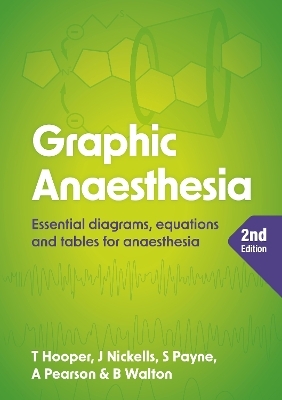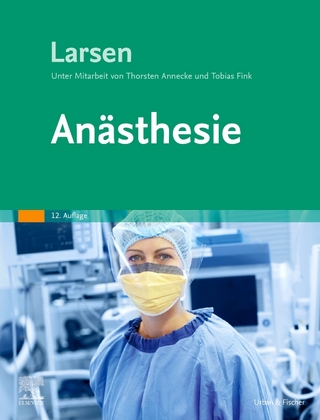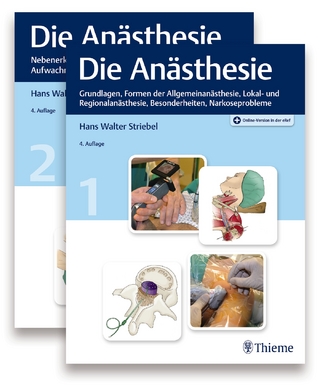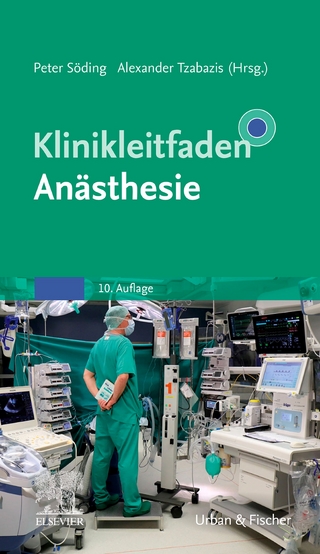
Graphic Anaesthesia, second edition
Scion Publishing Ltd (Verlag)
978-1-914961-30-4 (ISBN)
This is the first book to combine all of these illustrations in one volume; as such it provides an essential learning resource for candidates preparing for the FRCA exams.
Graphic Anaesthesia is a compendium of the diagrams, graphs, equations and tables needed in anaesthetic practice.
Each page covers a separate topic to aid rapid review and assimilation. The relevant illustration, equation or table is presented alongside a short description of the fundamental principles of the topic and with clinical applications where appropriate.
Now fully updated, this second edition contains 35 new topics, including significant additions to the drugs and equipment sections, and new sections on clinical prediction and anatomy related to regional anaesthesia.
The book includes main sections on:
physiology
pharmacodynamics and kinetics
physics
equipment
anatomy
drugs
clinical measurement
clinical prediction
statistics.
By combining all the illustrations, equations and tables with concise, clinically relevant explanations, Graphic Anaesthesia is therefore:
the ideal revision book for all anaesthetists in training
a valuable aide-memoire for senior anaesthetists to use when teaching and examining trainees.
From reviews of the previous edition:
"Graphic Anaesthesia is a well-written, easy-to-read book, ideal for trainees studying for primary FRCA examinations... It will be an ideal companion for preparing for exams." Ulster Medical Journal, May 2016
"Graphic Anaesthesia is an excellent revision tool that allows trainees approaching exams to prepare in an efficient and simple format. It is a refreshing and unique resource that should be included on any essential revision reading list." European Journal of Anaesthesiology 2016; 33: 610.
"The diagrams are very clear, the explanations accurate and concise and to pack 245 items into a small reference book is no mean feat…. Each diagram is drawn in just four colours to enable them to be reproduced easily from memory. This intuitive approach was an eye-opener to me and a valuable lesson in simplicity without losing any essential detail. This is something from which many educators could learn and indeed transfer that skill…This is a quality book that could be a useful investment across the spectrum of practitioners involved in anaesthesia and the teaching of anaesthesia." Journal of Perioperative Practice March 2017, volume 27, issue 3
1. PHYSIOLOGY
1.1 Cardiac; 1.2 Circulation; 1.3 Respiratory; 1.4 Neurology; 1.5 Renal; 1.6 Gut; 1.7 Acid–base; 1.8 Metabolic; 1.9 Endocrine; 1.10 Body fluids; 1.11 Haematology; 1.12 Cellular; 1.13 Immunity; 1.14 Muscle; 1.15 Pregnancy and paediatrics
2. ANATOMY
2.1 Functional anatomy; 2.2 Anatomy for regional anaesthesia
3. PHARMACODYNAMICS AND KINETICS
3.1 Clearance; 3.2 Compartment model – one and two compartments; 3.3 Compartment model – three compartments; 3.4 Dose–response curves; 3.5 Elimination; 3.6 Elimination kinetics; 3.7 Half-lives and time constants; 3.8 Meyer–Overton hypothesis; 3.9 Target-controlled infusions; 3.10 Volume of distribution; 3.10 Wash-in curves for volatile agents
4. DRUGS
4.1 Alpha 2 receptor agonists; 4.2 Anaesthetic agents – etomidate; 4.3 Anaesthetic agents – ketamine; 4.4 Anaesthetic agents – propofol; 4.5 Anaesthetic agents – thiopentone; 4.5 Local anaesthetics – mode of action; 4.6 Anticoagulants; 4.7 Antiemetics; 4.8 Antiplatelets; 4.9 Benzodiazepines; 4.10 Blood products; 4.11 Direct acting oral anticoagulants; 4.12 Intralipid; 4.13 Local anaesthetics – mode of actin; 4.14 Local anaesthetics – properties; 4.15 Neuromuscular blockers – mode of action; 4.16 Neuromuscular blocking agents – depolarizing; 4.17 Neuromuscular blocking agents – non-depolarizing; 4.18 Opioids – mode of action; 4.19 Opioids – properties; 4.20 Paracetamol and NSAIDs; 4.21 Reversal agents; 4.22 Tranexamic acid; 4.23 Volatile anaesthetic agents – mode of action; 4.24 Volatile anaesthetic agents – physiological effects; 4.25 Volatile anaesthetic agents – properties
5. PHYSICS
5.1 Avogadro’s hypothesis; 5.2 Beer–Lambert law; 5.3 Critical temperatures and pressure; 5.4 Diathermy; 5.5 Doppler effect; 5.6 Electrical safety; 5.7 Electricity; 5.8 Exponential function; 5.9 Fick’s law of diffusion; 5.10 Gas laws – Boyle's law; 5.11 Gas laws – Charles' law; 5.12 Gas laws – Gay-Lussac's (Third Perfect) law; 5.13 Gas laws – ideal gas law and Dalton’s law; 5.14 Graham's law; 5.15 Heat; 5.16 Henry's law; 5.17 Humidity; 5.18 Laser; 5.19 Metric prefixes; 5.20 Power; 5.21 Pressure; 5.22 Raman effect; 5.23 Reflection and refraction; 5.24 SI units; 5.25 Triple point of water and phase diagram; 5.26 Types of flow; 5.27 Wave characteristics; 5.28 Wheatstone bridge; 5.29 Work
6. CLINICAL MEASUREMENT
6.1 Bourdon gauge; 6.2 Clark electrode; 6.3 Damping; 6.4 Depth of anaesthesia monitoring; 6.5 Fuel cell; 6.6 Monitoring of neuromuscular blockade; 6.7 Oximetry – paramagnetic analyser; 6.8 pH measuring system; 6.9 Pulse oximeter; 6.10 Severinghaus carbon dioxide electrode; 6.11 Temperature measurement; 6.12 Thermocouple and Seebeck effect
7. EQUIPMENT
7.1 Bag valve mask resuscitator; 7.2 Breathing circuits – circle system; 7.3 Breathing circuits – Mapleson's classification; 7.4 Bronchoscope; 7.5 Cleaning and contamination; 7.6 Continuous renal replacement therapy – extracorporeal circuit; 7.7 Continuous renal replacement therapy – modes; 7.8 Gas cylinders; 7.9 Glucometer; 7.10 Humidifier; 7.11 Intra-aortic balloon pump; 7.12 Laryngoscopes; 7.13 Oxygen delivery systems – Bernoulli principle and Venturi effect; 7.14 Piped gases; 7.15 Scavenging; 7.16 Ultrasound; 7.17 Vacuum-insulated evaporator; 7.18 Vaporizer; 7.19 Ventilation – pressure-controlled; 7.20 Ventilation – volume-controlled; 7.21 Viscoelastic tests of clotting
8. STATISTICS
8.1 Mean, median and mode; 8.2 Normal distribution; 8.3 Number needed to treat; 8.4 Odds ratio; 8.5 Predictive values; 8.6 Sensitivity and specificity; 8.7 Significance tests; 8.8 Statistical variability; 8.9 Type I and type II errors
9. CLINICAL PREDICTION
9.1 ASA classification; 9.2 Clinical frailty scale; 9.3 Cormack and Lehane classification; 9.4 Mallampati classification; 9.5 Scoring systems
| Erscheinungsdatum | 11.07.2023 |
|---|---|
| Verlagsort | Bloxham |
| Sprache | englisch |
| Maße | 172 x 244 mm |
| Gewicht | 728 g |
| Themenwelt | Medizin / Pharmazie ► Medizinische Fachgebiete ► Anästhesie |
| ISBN-10 | 1-914961-30-7 / 1914961307 |
| ISBN-13 | 978-1-914961-30-4 / 9781914961304 |
| Zustand | Neuware |
| Haben Sie eine Frage zum Produkt? |
aus dem Bereich


